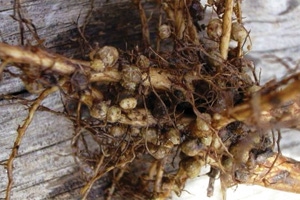January 27, 2011

High soybean prices are driving a new interest in rhizobial inoculants. “With soybean prices so high, everyone is looking for ways to increase yields,” says Jim Beuerlein, Seed Enhancement Biologicals, Becker Underwood, and agronomy professor emeritus, Ohio State University. “Many producers have turned to inoculation for that purpose.”
Plus, inoculants need only a modest yield increase to offset the cost. “A good inoculant will usually provide at least a 1- to 2-bu./acre return on yield,” reports Tim Maloney, Agri-Tech Consulting, Whitewater, WI. “For the cost of a typical inoculant, you’ll usually generate a $12 to $16/acre return based on $8/bu. soybeans. Most good-quality inoculants cost $5 to $7/acre.”
Another market driver is the high cost of seed and inputs. Growers use these products to help protect their investment in soybeans and maximize yields, adds Ryan Locke, EMD Crop BioScience.
The use of rhizobial inoculants has spread geographically as well. Dorn Severtson, Novozymes BioAg, says more growers in the south and east are trying inoculants.
Mixed bacteria and biologicals
Inoculant companies are meeting the demand by expanding their research on bacterial strains. “New strains are being tested against the current standards, and that’s good,” Maloney says.
“I see great development in the area of mixed strains of rhizobia,” he adds. “I’m seeing seed inoculants with two or more strains of bacteria, maybe a biological fungicide and other biologicals added to enhance the growth of root nodules and root hairs/root mass to improve nutrient uptake.”
Soil environments change year to year and within a year. Some strains of bacteria survive in lower pH levels, whereas others prefer higher soil pH levels. Some strains can perform in soils with higher levels of residual nitrogen. “Soybean inoculants undergo extensive testing to measure their compatibility with seed-applied fungicides, insecticides, nematicides,” Maloney says. “Current inoculants are bred to be aggressive, not lazy, nodulators.”
When to inoculate
Most industry experts say it is important to inoculate soybeans every year. “It’s commonly believed that if you keep soybeans in your rotation or plant soy on soy that you will have sufficient rhizobia for effective nodulation,” Locke says. “But over time, rhizobia native to the soil actually can become ineffective at nodulation.”
Weather plays a role in rhizobia populations. “In 2009, we had extended soil moisture while we waited to get corn harvested — not a great environment for rhizobia survival,” Maloney says. “Last fall, we had extended periods of dry weather and possibly a negative effect on rhizobia. The best plan is to treat soybeans every year with a quality, aggressive commercial inoculant.”
Will your soybeans produce root nodules if you do not add an inoculant? “If you have grown soybeans only once in a field over the past 10 years, the soybeans will still form root nodules,” Maloney says. “But the bacteria will be lazy and poorly convert nitrogen to the plant.” The longer a strain of bacteria has survived in the soil, the better it gets at surviving without fixing nitrogen. “A commercially applied seed inoculant is bred to form nodules and fix nitrogen,” Maloney says. “That’s what you want.”
Dealer- vs. farmer-applied treatments
Farmers can inoculate their own soybeans. But because the equipment is specialized and the treatments complex, company specialists like Locke recommend growers use dealers to apply the inoculants. Many new liquid formulations of inoculants are designed for application by the retailer.
“While there is a cost difference, the added benefits are many,” Locke says. “A retail-applied application provides better coverage, more accurate application, added convenience and the ability to treat a full treatment package.”
“Many producers with more acres to cover like the time savings of dealer-applied seed treatments,” reports Marty Robinson, Advanced Biological Marketing. “We see dealerships charging no more than a dollar an acre, if that, for custom application fees. However, enough good on-farm application equipment has now been developed that a 1,500-acre soybean farmer, for example, can pretty easily apply nonrestricted use products in the field.”
Photo courtesy of Advanced Biological Marketing
About the Author(s)
You May Also Like




